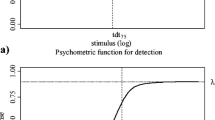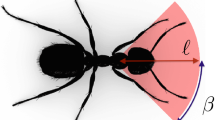Abstract
Graphs and simple Gaussian plume equations are presented for estimating the maximum horizontal area within a pheromone plume. In its simplest form the area,A R , for a given scaling factor,R = Q/(Ku), isA R = AI R β, whereQ is the release rate,K is a specified concentration threshold,u is the wind velocity, and β is an atmospheric stability index. Estimates ofA I and β are given for several atmospheric stability typing schemes applicable to field and forest habitats.
Similar content being viewed by others
References
Aylor, D.E., Parlange, J., andGranett, J., 1976. Turbulent dispersion of disparlure in the forest and male gypsy moth responses.Environ. Entomol. 5:1026–1032.
Baker, T.C., andKuenen, L.P.S. 1982. Pheromone location in flying moths. A supplementary non-anemotactic mechanism.Science 216:424–427.
Bossert, W.H., andWilson, E.O., 1963. The analysis of olfactory communication among animals.J. Theor. Biol. 5:443–469.
Briggs, G.A. 1973. Diffusion estimation for small emissions, ATDL contribution file no. 79, Atmospheric Turbulence and Diffusion Laboratory, Oak Ridge, Tennessee.
Cramer, H.E., Record, F.A., andVaughan, H.C. 1958. The study of the diffusion of gases or aerosols in the lower atmosphere. Report AFCRC-TR-58-239, Department of Meterology, M.I.T., Cambridge, Massachusetts.
David, C.T., Kennedy, J.S., Ludlow, A.R., Perry, J.N., andWall, C. 1982. A reappraisal of insect flight towards a distant point source of windborne odor.J. Chem. Ecol. 8:1207–1215.
Eimutis, E.C., andKonicek, M.G. 1972. Derivations of continuous functions for the lateral and vertical atmospheric dispersion coefficients.Atmos. Environ. 6:859–863.
Elkinton, J.S., andCardé, R.T. 1984. Odor dispersion, pp. 73–91,in W.J. Bell and R.T. Cardé (eds). Chemical Ecology of Insects. Chapman and Hall, London. 524 pp.
Elkinton, J.S., Cardé, R.T., andMason, C.J. 1984. Evaluation of time-average dispersion models for estimating pheromone concentration in a deciduous forest.J. Chem. Ecol. 7:1081–1108.
Elliot, W.P. 1959. The areas within concentration isopleths downwind of continuous point source.Int. J. Air Pollut. 2:115–126.
Elliot, W.P., andNickola, P.W. 1961. The estimation of areas within isopleths of dosage downwind of a point source.Am. Ind. Hyg. J. 22:238–244.
Fares, Y., Sharpe, P.J.H., andMagnuson, C.E. 1980. Pheromone dispersion in forests.J. Theor. Biol. 84:335–359.
Farkas, S.R. andShorey, H.H. 1974. Mechanisms of orientation to a distant pheromone source, pp. 81–95,in M.D. Birch (ed). Pheromones. American Elsevier, New York. 495 pp.
Geiszler, D.R., Gallucci, V.F., andGara, R.I. 1980. Modeling the dynamics of mountain pine beetle aggregation in a lodgepole pine stand.Oecologia 46:244–253.
Gifford, F.A., Jr. 1961. Use of routine meterological observations for estimating atmospheric dispersion.Nucl. Saf. 2:47–57.
Gifford, F.A., Jr. 1976. Turbulent diffusion-typing schemes: A review.Nucl. Saf. 17:68–86.
Hanna, S.R., Briggs, G.A., andHosker, R.P., Jr. 1982. Handbook on Atmospheric Diffusion. DOE/TICK-11223. National Technical Information Service, U.S. Department of Commerce, Springfield, Virginia. 102 pp.
Hartstack, A.W., Witz, J.A., Hollingsworth, J.P., andBull, D.L. 1976. SPERM—a sex pheromone emission and response model.Trans. ASAE 19:1170–1174, 1180.
Hilsmeier, W.F. andGifford, F.A., Jr. 1962. Graphs for estimating atmospheric dispersion. USAEC Report ORO-545, Weather Bureau, Oak Ridge, Tennessee.
McClendon, R.W., Mitchell, E.B., Jones, J.W., Mckinion, J.M., andHardee, D.D. 1976. Computer simulation of pheromone trapping systems as applied to boll weevil population suppression: A theoretical example.Environ. Entomol. 5:799–806.
Nakamura, K., andKawasaki, K. 1977. The active space of theSpodoptera litura (F.) sex pheromone and the component determining this space.Appl. Entomol. Zool. 12:162–177.
Nishiwaka, Y. 1959. On the method of estimation of the population dose, population, and surface area covered by the diffusion of radioactive clouds.J. Atomic Energy Soc., Jn. 1:1–23 (translated as USAEC Report AEC-tr-4463).
Pasquill, F. 1961. The estimation of the dispersion of windborne material.Meterol. Mag. 90:33–49.
Shapas, T.J., andBurkholder, W.E. 1978. Patterns of sex pheromone release from adult females, and effects of air velocity and pheromone release rates on theoretical communication distances inTrogoderma glabrum.J. Chem. Ecol. 4:395–408.
Slade, D.H. (ed). 1968. Meterology and Atomic Energy 1968. TID-24190. USAEDC, Oak Ridge, Tennessee. 445 pp.
Tadmor, J. andGur, Y. 1969. Analytical expression for this vertical and lateral dispersion coefficients in atmospheric diffusion.Atmos. Environ. 3:688–689.
Wall, C., Sturgeon, D.M., Greenway, A.R., andPerry, J.N. 1981. Contamination of vegetation with synthetic sex-attractant released from traps for the pea moth,Cydia nigricana.Entomol. Exp. Appl. 30:111–115.
Author information
Authors and Affiliations
Rights and permissions
About this article
Cite this article
Stanley, B.H., Hummel, H.E. & Ruesink, W.G. Estimating maximum horizontal area of pheromone plumes. J Chem Ecol 11, 1129–1146 (1985). https://doi.org/10.1007/BF01020680
Received:
Accepted:
Issue Date:
DOI: https://doi.org/10.1007/BF01020680




